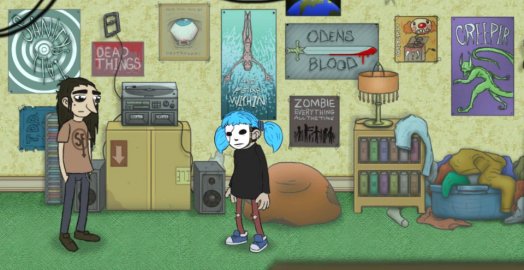

Events continue to weave in and out of this framework for most of the game, showing all the friends he’s made, as well as the frightening and horrible events he’s witnessed through the years. Sal’s adulthood acts as a framework for the game’s story, which involves an interview between him and a psychologist as he awaits a murder trial. The story stays appropriately dark and dreary, as you work your way through different periods of Sal’s life and learn about all the experiences that put him in his current situation. Since the story is such a focus of the game, I’ll try not to spoil too much about what goes on, but I do need to talk about some of the elements found throughout.

The momentum of the story did help the game’s progression, which I appreciated. This led to some dull moments here and there, though I generally stayed invested in the story throughout. Most of the game progresses in a pretty linear fashion, focusing more on the story, rather than on gameplay elements or puzzles, which can be a good or bad thing, depending on what you’re looking for. The game’s sound effects and music are consistently disturbing, from the horrible screams of ghosts and demons to the warbly guitars and synths of the soundtrack. Overall, it’s like a more goth-rock version of Hotline Miami‘s uncomfortable soundtrack. That said, Sally Face still manages to stand out as fairly unique title among its peers. I found some similarities in the gameplay, story, and aesthetic of the game to other titles released in the last 10 years or so, such as Fran Bow and The Cat Lady to name a few. These are a nice touch and don’t overstay their welcome.
Sally face switch portable#
There’s a fun mechanic where you use Sal’s portable gaming device to interact with the spirit world (a concept fairly lifted from the Nintendo DS horror series Nanashi no Game) and unlock some fun, retro-inspired minigames that help you flesh out the backstory of the town and some of its inhabitants. Many hidden or optional objects will not show this prompt, since you’re supposed to be able to find them on your own, but most of the game consists of interaction with simple objects or conversations with people you meet. There’s no cursor for you to move around and click objects, but merely on-screen prompts that indicate when you can interact with something important. The gameplay itself plays like a simplified version of the point-and-click adventure formula, with a completely 2D aesthetic and only one plane of movement. You’ll also notice right from the start that the game features a unique visual style that incorporates influences from several kinds of media including children’s cartoons from the 1990s to the present, Tim Burton films, and several other dark fairy tale elements. It can still be a little jarring as you progress through the overall narrative. It should be noted that the game also jumps around in time very frequently, though it’s usually pretty apparent by the age and appearance of Sal. As a result, he chose to wear a mask as his “prosthetic.”įrom the very start, the game thrusts you into some very strange and unsettling situations, like waking up in a hospital after having several nightmares and not knowing where you are. Sally Face is the story of a boy named Sal who inherits the enigmatic nickname “Sally Face” after suffering an accident as a child, which left his face badly scarred.
Sally face switch full#
The full game has now released on the Nintendo Switch, including all five episodes, in an effort to reach a wider audience.

A few years later, in 2019, the final episode was released, after which Sally Face received a lot of critical acclaim and a enjoyed a cult following of sorts.įast-forward to January 2021. Created by a solo indie developer named Steve Gabry during a dark time in his life, the game was an attempt at self-expression and getting through these times by having a creative outlet to share with the world. It started its journey with the release of its first episode back in 2016 on PC. Sally Face is a game you may have heard of before.


 0 kommentar(er)
0 kommentar(er)
